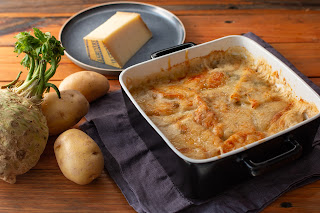Celeriac and potato dauphinoise
Potatoes are my favourite vegetable! I don't think you can serve them in a way that isn’t delicious and filling. A particularly decadent way of serving them is in a bubbling creamy sauce. The French, of course, developed more than one way to serve bubbling creamy potatoes - gratin and dauphinoise. Potatoes au gratin are slices of pre-cooked (usually boiled) potatoes cooked in cream with added flour and topped with cheese in a shallow baking dish. Dauphinoise, on the other hand, is a dish made of thinly-sliced (not pre-cooked) potatoes that cook in cream and baked at a lower temperature so that the potatoes cook through without becoming too crunchy on top. Dauphinoise are usually cooked in deep baking dishes. These differ from scalloped potatoes, which are made with a flour-butter-milk roux.
When choosing potatoes, floury varieties such as Coliban, King Edward, Sebago, or Golden Delight are ideal. In Australia, the most common starchy potato is Sebago (those dirt-brushed potatoes), Dutch creams, or Red Delight. In America – the Russet variety and for those of you in Europe, King Edward or Maris Piper are perfect. These potatoes are high in starch and low in moisture, resulting in dry, flaky flesh that breaks down and fluffs up when cooked, absorbing other liquids and flavours—particularly milk and butter. If you use waxy potatoes, the layers slip and slide when serving.Celeriac is not a vegetable that I grew up with. It is very versatile a
nd can be eaten raw (e.g., in celeriac remoulade) or it can be cooked. It is quite sweet with a subtle celery flavour and lower in carbohydrates than potatoes. It is in season from May to August in the Southern Hemisphere or September to April in the Northern Hemisphere. It has plenty of health benefits including being a source of vitamins B6, C, and K, fibre, antioxidants, and minerals. I often boil it in milk and mash it, serving as an alternative to mashed potatoes.
Combining these two vegetables lightens this dish a little without removing its decadence. The choice of cheese will change the flavour of this dish. Gruyère is the best as it provides flavour and browns beautifully on top. It’s quite expensive so for everyday purposes, you can substitute Colby, Cheddar, Havarti, or Tasty cheese.
This dish can be reheated the next day, allowing the flavours to further develop. Perfect for lunch with a crisp green salad, or as an accompaniment with roasted meats.
Serves 4
- 1 medium celeriac (approx. 400 g)
- 500 g potatoes, floury variety recommended (e.g., Coliban, King Edward, Sebago, Golden Delight)
- 200 ml cream
- 200 ml milk
- 2 cloves garlic
- 2 tsp freshly grated nutmeg
- Salt and pepper to taste
- 1 tbl fresh thyme (optional)
- 100 g Gruyère cheese, grated
- Knob of butter
Preheat the oven to 160°C fan/180°C.
First, slice your celeriac and potatoes into thin slices.
Place the slices of celeriac and potatoes in a large saucepan and add the garlic, cream, milk, and nutmeg. (It won't cover the vegetables). Cover with a lid and bring to a simmer on medium heat and cook gently for 5 minutes. Add thyme if using.
Remove from the heat and allow to cool slightly.
Grease a baking dish with the butter. Using a slotted spoon, lift out the vegetables and arrange them in the baking dish in flat layers. Press down to create a firmly packed and even layer. Season with salt and pepper between layers. Pour the creamy liquid over the top and gently shake the dish to distribute the liquid and ensure an even layer in the dish. Scatter over the Gruyère cheese.
Bake for 45 minutes until the top bubbles and turns golden brown. Let stand for 15 minutes before serving.
Serve with roast meat or a side salad for a light lunch.




Comments